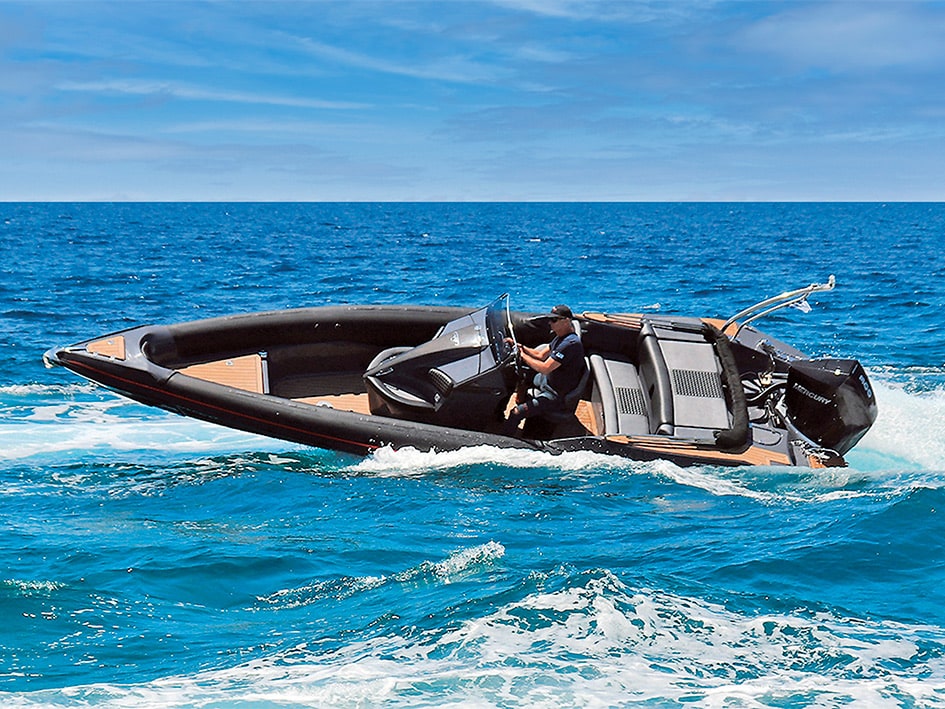As fast as it is striking to look at, this 62 knot radical RIB packs in a host of practical features.
Most successful high-performance boats generally have a pedigree to rest their laurels on. For the Greek-built Tropida Saita 7.80, this is the twin-stepped deep-vee design of Adam Younger. Founded by designer and powerboat racer Takis Samartzis, Tropida have only been in the running since 2014; however, in this period they have launched some serious high-performance RIBs, of which the Saita 7.80 is the smallest in the range.
If you are not familiar with Adam Younger, his design work stretches back three decades, with the likes of Cougar Marine, Revenger and the RNLI on his CV. This hull is his work, albeit with some additions from Takis Samartzis. The transom deadrise is a very respectable 23 degrees, sharpening to a dagger-like 50 degrees at the bow. It has a mildly concave profile to soften the ride further, twin steps, and the bow has an unusual addition of an ‘anti-dive system’ consisting of ‘bow steps’. Designed by Takis, this anti-dive system is composed of two steps right at the top of the stem, which widen to create a collar around the forward tip of the tubes. This is to reduce the possibility of stuffing the nose, by widening and stiffening the very sharp bow profile, and increasing buoyancy to a degree. It is hard to speculate on just how effective it is, but with such a sharp entry to the hull, and the absence of any upward flair on the forward section of the tubes, it can’t be a bad thing.
Power comes from Mercury, ranging from 150hp to the 300hp Verado. Any of Mercury’s engines from the 225hp V6 to the 300hp V8 will make this 900kg boat a very lively drive, and frugal into the bargain. Tropida claim 5.7mpg for the 300hp Mercury at a cruising speed of 36 knots. Even allowing for ‘optimistic error’, this is a good fuel return, and although Mercury’s new V8s have proven efficient, credit should also be given to the hull design. Weight is kept down by constructing the fuel tank from vinyl ester resin, combined with an absence of wood in the transom. Structural rigidity is enhanced through an independent framework of GRP bulkheads and stringers.
All decking is synthetic teak, which at the stern starts with a small bathing platform on the port quarter, hiding a neatly concealed fold-out bathing ladder. Immediately forward of this lies a small hatch revealing a compartment for the deck shower, and storage for warps. On the opposite quarter sits a slide-out emergency outboard engine bracket – something boat designers have forgotten about in recent years. Along with a swept-back nav-light/VHF pole, an aft windlass sits on the starboard quarter – a feature favoured by Scandinavians that is sadly not often seen outside the Baltic, and rarely, if ever, in RIBs. Stepping forward from the bathing platform is a synthetic teak-capped raised coaming, designed to provide a walkway into the boat, which with its starboard counterpart provides enclosed security for those sitting in the aft bench seat. Beneath the bench seat lies an icebox and storage, while the sunbed behind measures 1.9m x 0.69m, with a big storage cavity beneath.
The helm seats, which are designed to offer comfort and good side support, allow driving in three positions – sitting, standing and leaning. This is enabled by the shape of the lower section, which allows you to place your legs around the centre section of the seat base. Consideration has been given to the design of the console, providing protection while being aerodynamic at the same time. The stylish dashboard uses an impressive combination of real carbon fibre and leather, while leaving sufficient space for all the instruments. The forward section of the boat has the option of either a drop-in double sunbed or a small table – served by two seats on the face of the console and a seating cushion on the bow storage locker. The interior of the console can come specified with a chemical toilet or simply be left as another large storage cavity – accessed through the whole forward section hingeing up.
Though this boat has been designed as a white-knuckle 60 knot+ sports boat, it appears its designer has left few stones unturned in terms of making good use of every inch of space. Production started in 2020, and at present the nearest dealer is based in Germany. For the Carbon Edition fitted with a 300hp Mercury Verado, prices will start at 96,000 euros (inc. VAT).
Specifications
- LOA: 7.8m (25ft 9in)
- Beam: 2.47m (8ft 2in)
- Draught: 0.36m (3ft 2in)
- Displacement: 900kg (dry)
- Transom deadrise angle: 23˚
- Fuel capacity: 250L (55 gal)
- Engines: 150 – 300 hp Mercury outboards
- Range: 180nm at 36 knots – 300hp option (with 20% reserve)
- Performance: Maximum of 62 knots with 300hp Mercury
- CE Rating: C
Price
96,000 euros (inc. VAT) with 300hp Mercury Verado














